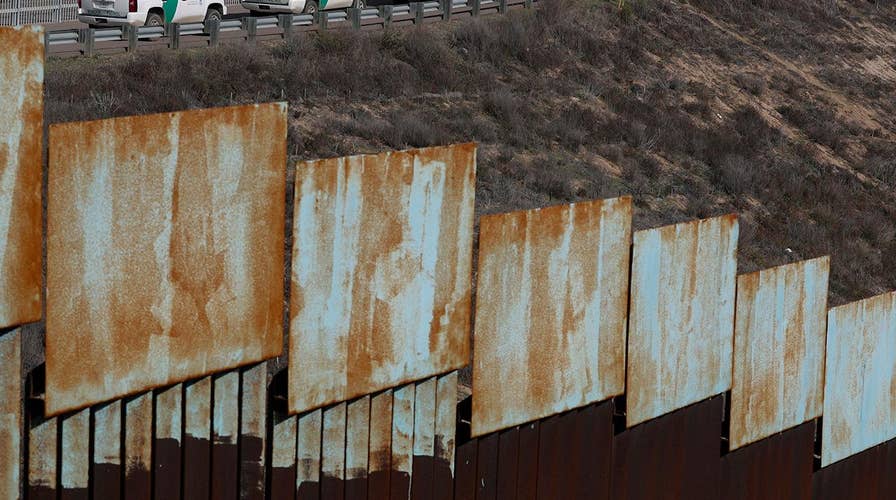Can Trump, Democrats bridge the gap on border security?
The 'Outnumbered' panel reacts to the heated Oval Office meeting between the president, Pelosi and Schumer on funding the border wall.
As a staunch supporter of refugees and the American dream, I find most of the rhetoric behind the idea of the wall flatly un-American. However, no one with a brain can argue that we shouldn’t have border security.
The Trump administration wants to enforce border security with a combination of a physical wall and natural barriers that would protect the estimated 1,933 miles-long border between the United States and Mexico. Many different cost estimates have been thrown around, from as little as $8 billion to as much as $70 billion, with anywhere from $150 million per year to $750 million per year in maintenance.
As a statistician, I want to take a look at how much the wall is actually going to cost. Now, as with anything, there are unintended costs and benefits, and it is impossible to account for everything that could possibly be affected (trying to do so leads to cherry-picking what you will and won’t use). So, in order to give my estimated cost, I’m going to be transparent with every piece of information I give.
Let’s get started.
In 1993, President Bill Clinton mandated the construction of a 14 miles-long wall between San Diego, California and Tijuana, Mexico to stem the flow of illegal immigrants and drugs across our border. Then, in 2006, the Secure Fence Act under President George W. Bush authorized the construction of physical barriers (a wall and fences) along another 654 miles. About 130 miles of the border without a physical barrier has natural barriers.
So really we are talking about roughly 1,150 miles. If you drive at 60 miles per hour, that would take you about 19 hours as the eagle flies.
Alright, now let’s get out our calculators.
Construction
Size of the wall: 1,150 miles long; 40 feet high; 10 feet deep into the ground; 1 foot wide
Total volume of material: 11.2 million cubic yards
Materials: Approximately $8.7 billion in concrete (97 percent of the materials); approximately $3.6 billion in steel (3 percent of the materials)
Labor: Approximately $12.3 billion (given the labor costs on the original 654 miles of barriers we can assume a conservative 1:1 ratio of materials to labor)
Land acquisition: About 60 percent of the border is privately owned land. While the federal government has the power to take privately owned property for public purposes, it must provide “just compensation.” Based on previous purchases from the 2006-2009 wall construction, the cost at most would be $300,000 per mile acquired, or approximately $200 million altogether.
In total, the actual physical cost of the wall would be about $25 billion. That sounds like a ton of money. But it isn’t just one person paying for it – the entirety of the U.S. taxpayer base would collectively foot the bill.
To put that in perspective, we could give 50,000 small businesses $500,000 each to get their businesses up and running. That would be pretty incredible. On the other hand, we spend a lot of money on some absolutely ridiculous things. The taxpayer-funded National Science Foundation gave almost $200,000 to a researcher to study the gambling habits of monkeys. What was the result? Nonsensical animal testing and suffering so we could find out that monkeys like to gamble. Come on.
I could easily come up with $25 billion dollars in our federal budget that are wasted each year. No problem.
Now, I’ve estimated the cost of the wall to be about $25 billion, but many of the estimates given by other sources include many other factors: how many more or fewer border agents are needed; reduction of “virtual” walls; on-going maintenance; economic costs to border towns; reductions in human trafficking and illegal immigration; reduction in drug trafficking; etc.
There are so many factors that “might increase” or “might decrease” that as a statistician, I can tell you it is empirically impossible to calculate all of the unintended consequences – good or bad – that the wall might cause. Anyone saying otherwise is flat out wrong.
For example, according to the Washington Office on Latin America (WOLA), an advocacy group for human rights, the number of illegal immigrants being “apprehended at the U.S. border is near its lowest level since the 1970s.” That is true. But what this statistic doesn’t show is that the number of illegal immigrants apprehended at the border steadily increased until 2000, and only began to decrease substantially in 2006 when the Secure Fence Act came into effect.
Here’s another misconception. According to a 2015 report by the U.S. Drug Enforcement Administration, 95 percent of drugs enter the United States via container ships or other vessels. So in reality, a wall is going to do absolutely nothing to stop drug trafficking.
One single number never tells the whole story. I could come up with multiple caveats to anyone’s calculations (including my own).
When I was 14 years old, my father and I went to Ellis Island. My grandmother’s signature, faded but still clear, “Belle Mack” was right there next to the thousands of others who had fled their own countries to come to America and start a new life. Immigration is as much a part of America as the flag, but in order to protect that dream and those rights, all new immigrants’ names must be written down, just like my grandmother’s.
The real question the American public should be asking isn’t how much is the wall going to cost, but rather what is the best way to secure our borders and reduce illegal activity like human and drug trafficking, while at the same time promoting the American dream and helping those who are fleeing for their lives?
The question shouldn’t be about the dollar cost of the wall. It should be about the validity of the wall.

